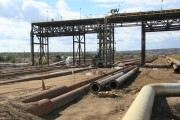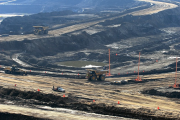Over the last six weeks, Albertans have had a rare
opportunity to shape the environmental management of the oilsands by
commenting on the provincial government's draft plan for the Lower
Athabasca region.
The plan is an important first step, as
Albertans have consistently demanded improvements in oilsands
environmental management. But as that window of opportunity closes, the
question is whether the province will take the public's input into
account by making much-needed improvements to the draft plan before it
goes to cabinet next month.
While it is now widely acknowledged that Alberta needs a plan to guide oilsands development, it is clear the current draft won't meet the provincial government's own vision for the plan, which is in part to ensure that the "region's air, water, land and biodiversity support healthy ecosystems and world-class conservation areas."
That particular aspect of the plan's vision is attainable — and the current draft of the plan makes progress by tightening rules for air pollution and acknowledging that environmental limits must be set for other kinds of oilsands impacts. But many of the critical pieces required to genuinely protect land, air, water and ecosystems are still missing.
For instance, the draft plan defers for more than two years setting a limit on the amount of land that can be developed at any time. It does not require companies to stop taking water from the Athabasca River during low-flow periods, nor does it identify downstream limits for hydrocarbon pollutants, despite the recent confirmation of oilsands pollution in the Athabasca River. And while there has been much fanfare around the new conservation areas identified in the plan, the boundaries of those areas fail to protect many ecologically significant areas that are essential to maintaining the health and proper functioning of vulnerable species and entire ecosystems.
By protecting very little habitat of the declining woodland caribou and avoiding taking meaningful action on caribou for another two years, the plan — as currently written — will lead to more uncertainty, conflict and lawsuits around the management of this iconic and threatened species. And similar conflicts could arise over land-use issues in northeastern Alberta, because in developing this plan, the provincial government neglected to meaningfully engage First Nation communities in the co-operative management of those landscapes.
In other words, the current draft plan does more to defend the interests of oilsands developers than it does to protect the quality of Alberta's environment.
For nearly two decades, the Pembina Institute has worked to identify effective solutions to the environmental impacts of oilsands extraction — and the good news is the solutions are plentiful. Over the years, we have participated in government processes such as the Cumulative Environmental Management Association and intervened in oilsands regulatory hearings as a member of the Oilsands Environmental Coalition. We've spent more than a decade pushing the province to identify and enforce science-based environmental limits on oilsands development, and we've produced more than 40 publications documenting the solutions that are available.
Our experience working toward those solutions informed our latest report, Solving the Puzzle: Environmental Responsibility in the Oilsands, which outlines 19 policy recommendations to address the real issues that give the oilsands such a bad rap internationally. Many of the policies we recommend would help to improve the land-use plan for the Lower Athabasca region, as outlined above. But we also look to address big-picture issues — such as placing a price on carbon emissions that's high enough to drive real reductions in greenhouse gases, and outlining the criteria required to build a truly world-class environmental monitoring system in the oilsands.
Putting these policies in place would allow the Alberta government to credibly say they are making real progress on protecting air, land, water and wildlife — while taking appropriate steps to curb the greenhouse-gas pollution that triggers climate instability. The solutions we point to are rigorous, but they're also practical and grounded in Pembina's consulting work with industry, government and communities. Most importantly, our recommendations are consistent with the best available science and have been developed from leading policies in other jurisdictions.
There is still time for Alberta to get it right and produce a world-class land-use plan for the Lower Athabasca by ensuring the final draft gets the stamp of approval from independent scientific experts at arms' length from the Alberta government and industry. Doing so could go a long way toward restoring Albertans' and Canadians' pride in the oilsands — and reassure an increasingly skeptical international marketplace that oilsands development in Alberta is being regulated appropriately.
Jennifer Grant is director of the Pembina Institute's oilsands program and a lead author of the report Solving the Puzzle : Environmental Responsibility in the Oilsands
The consultation period for the draft Lower Athabasca Integrated Regional Plan closes on June 6.






